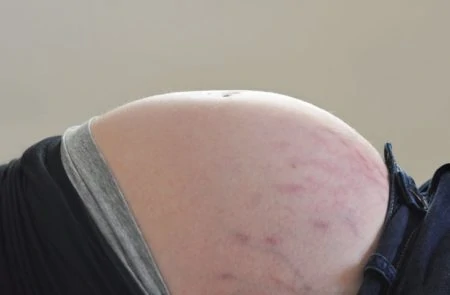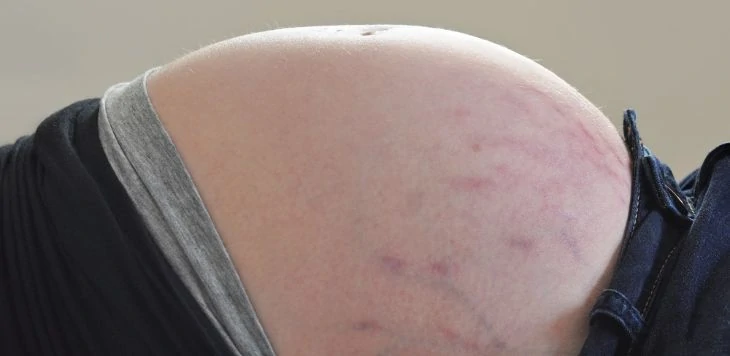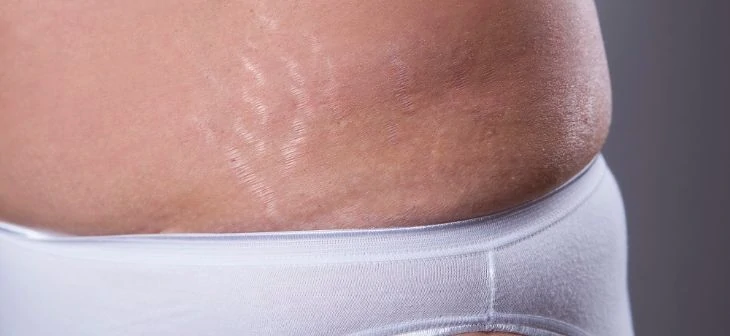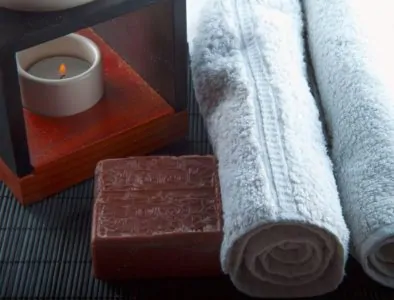Are you struggling with stretch marks during pregnancy?
While completely eliminating stretch marks during pregnancy is out of your power, you can cut back on how many you get.
In this article, we’ll discuss the causes of stretch marks, and how you can help prevent them during your pregnancy.
Causes of Stretch Marks During Pregnancy
The key to beating your enemy is to understand it. By figuring out what causes stretch marks in the first place, you just might be able to outsmart them.
At the very least, you’ll be able to understand why the stretch marks keep cropping up on your body. Knowing why they’re happening may help you accept them a little more graciously. Although it sucks, a bunch of stretch marks is well worth the end result!
How Do Stretch Marks Form?
Stretch marks form when your skin is stretched or pulled further than it is comfortable with, especially if the growth is rapid as it is during pregnancy.
Skin is typically pretty elastic, but if it is stretched too far, too quickly it can mess with the production of collagen. Collagen is the protein responsible for the connective tissue your skin has.
Your skin has three layers (1):
- The epidermis, or the outer layer.
- The dermis, the middle layer that contains connective tissue, sweat glands, and hair follicles.
- The hypodermis, the deepest layer which is comprised of connective tissue and fat.
Stretch marks form in the dermis layer when rapid growth leads to a tear in the dermis. That tear lets the hypodermis become visible through the skin, which is why they take on the appearance that they do (2).
While they can be unsightly, don’t feel bad if you get them. More than half of all pregnant women will. Some doctors put that number at closer to 90 percent.
How to Prevent Pregnancy Stretch Marks
With so many women being prone to developing stretch marks, the obvious question that comes to mind is what can be done to prevent them from happening in the first place. Is there some way women don’t have to deal with this lifelong side effect of pregnancy?
Can Stretch Marks Actually Be Prevented?
While there are no magical solutions for stretch marks when it comes to prevention and treatment once they are already there, there are some things you can try to help lessen the damage to your skin.
Let’s look at some of the things that are important when it comes to the formation or the possibility of avoiding the formation of stretch marks.
- Skin elasticity: There’s nothing you can do about this. Your skin’s elasticity has already been determined.
- Nutrition: Nutrition can play a role in the development of stretch marks. By choosing to eat whole foods, such as fruits and vegetables, instead of potato chips and ice creams, and other foods you crave, you might ward off some stretch marks. Your body will have the nutrients it needs to work in tip-top condition and whole foods tend to be lower in calories too so you’ll have a less dramatic weight gain.
- Hydration: Keeping your skin well hydrated with the best stretch mark cream may help with some of the stretchings and pulling. At the very least, your belly should feel more comfortable and less itchy when you apply lotion. You should also drink enough water to keep your body well hydrated.
Keep In Mind

1. Stay Hydrated
During pregnancy, you need more water because you have increased hydration needs. Getting more water can help you though, both internally and externally. To make the most of its elasticity, your skin should be properly hydrated.
You should be drinking a minimum of 8 glasses of water a day. If you find you hate drinking that much water, you can buy a naturally flavored seltzer instead or jazz up your water with some lemon slices.
If you’re still tired of drinking water, try to incorporate some extra juicy fruits into your diet. Watermelon for instead contains a lot of liquid so it’s a good choice when you need some extra hydration.
While you’re shooting to stay properly hydrated, pay attention to signs that you might be dehydrated. That can be a problem with pregnant women, especially if you’re vomiting from morning sickness or if you’re pregnant during the heat of the summer.
Look For
2. Coconut Oil
You can rub a lotion made with coconut oil or even pure coconut oil on your belly to keep it hydrated and itch-free. It’s worth a shot and at least you’ll smell good while trying to ward off those stretch marks.
The oil won’t hurt your baby or you, since it’s something you could safely consume anyway. To use coconut oil, you can rub some on your belly in the morning, afternoon, and before bed.
Another good time to put it on is when you get out of the shower. Do it while your skin is still damp so help absorb the moisture and to prevent your skin from drying out from the heat of your shower.
3. Olive Oil
If you can’t stomach the smell of coconut oil or if you have a coconut allergy, regular olive oil is a great alternative. It’s widely available and affordable — you probably already have some in your kitchen. Vitamin E is another oil you can use. Both oils have antioxidant properties as well.
Apply it just as you would the coconut oil we discussed in the last step.
4. Vitamin C
Vitamin C has enjoyed a long reputation as being a great wound healer. Following surgery, doctors often recommend making sure you get enough Vitamin C to speed up the healing process.
It stands to reason then that Vitamin C can be beneficial at helping stretch marks too. Although it may play a role in helping stretch marks heal, it can also help your collagen form.
Instead of merely taking a supplement, which is likely in your prenatal vitamin anyway, you should opt for eating Vitamin C-rich food instead.
Add strawberries, broccoli, oranges, bell peppers, and kale into your diet. You’ll also benefit from the fiber and other nutrients in those foods.
5. Zinc
Having too little zinc circulating in your body might be hurting your chances of avoiding stretch marks. Zinc is a mineral that is important in the formation of collagen.
Again, you shouldn’t add a zinc supplement unless your doctor tells you to — it’s likely contained in your prenatal vitamin and you don’t want to get more than you need.
You should focus on getting more zinc in your food instead. Eat more nuts, seeds, and whole grains.
6. Create Your Own Stretch Mark Cream
Instead of buying a cream or lotion that has ingredients you can’t even pronounce, you can make your own with a few simple ingredients.
You can make your own cream by using olive oil, coconut oil, beeswax, and Vitamin E.
For the base cream, you should mix together one cup of olive oil, one cup coconut oil, and a half cup of beeswax. Then you can add the Vitamin E oil if you desire.
To do it, you’ll put them all in a glass jar. Put the jar in a pot of boiling water — making sure the water doesn’t reach the edges and get into the jar. As the wax and oils melt, you’ll stir them together.
When they cool, they’ll be ready to be used. You can put this on your belly morning, noon, and night.
7. Shea or Cocoa Butter
There is no scientific proof this remedy works, but many moms swear by it just the same. At the very least, it won’t hurt you to rub shea or cocoa butter on your belly two or three times a day.
It should feel soothing because of the moisture and hydration these emollients will provide.
8. Calorie Control
It can be tempting to eat as much as you want while you’re pregnant, but that’s definitely a recipe for getting stretch marks. If you gain weight rapidly because you’re eating too many calories and giving in to all your pregnancy cravings, you may end up regretting it.
Stick to what your baby needs and fight your hunger by going for walks, drinking water, and eating fruits and vegetables.
9. Belly Rubs
Doing some light massages on your belly will help keep your skin elastic. Will it prevent stretch marks? There’s no conclusive answer to that.
But at the very worst, you’ve spent a few minutes rubbing and relaxing your belly. Better yet, have your partner do it for a relaxing time for you. Kick your feet up and enjoy the attention — it’s the least your spouse can do.
To do a belly massage, use gentle strokes — circular or down the length of your belly. You can do it as often as you’d like every day.
10. Exercise
Exercise is great for your pregnancy any way you look at it. It can help with your circulation, blood sugars, and it’s beneficial for your baby.
It may also help you keep the extra pounds off by burning excess calories and reducing your appetite and cravings, which could reduce your risk of getting stretch marks.
Is this a surefire method for preventing them? No, it doesn’t come with any guarantees. But you’ll be doing something that’s good for both you and your baby.
You don’t have to do vigorous exercise to get the benefits. You can go for walks after dinner most days of the week to get this benefit, or hit your local pool, which will also good feel good on your back pains and aching joints.




















